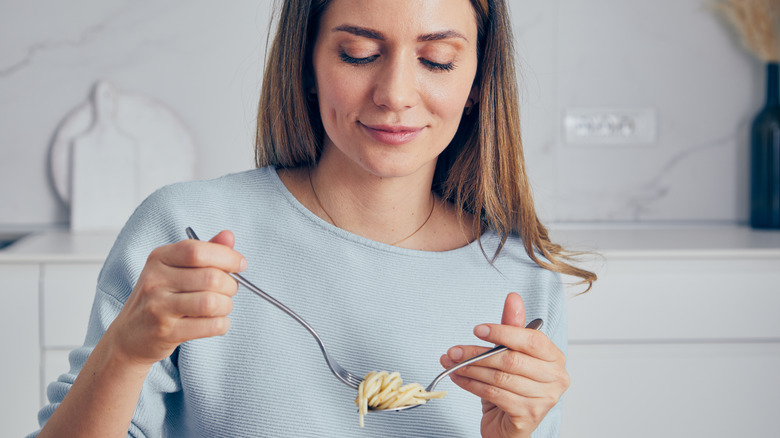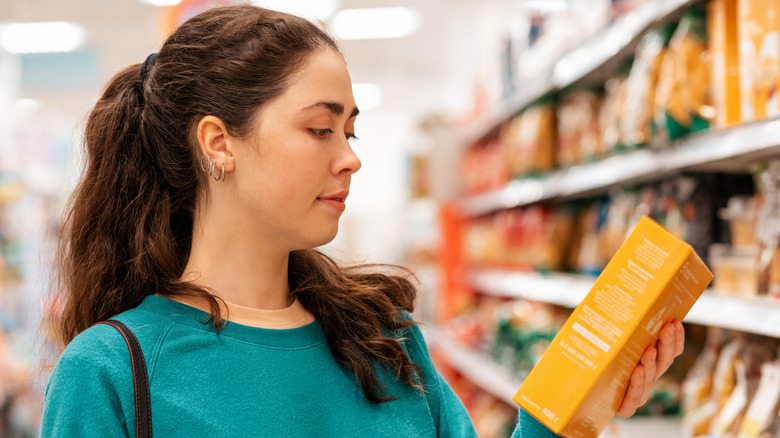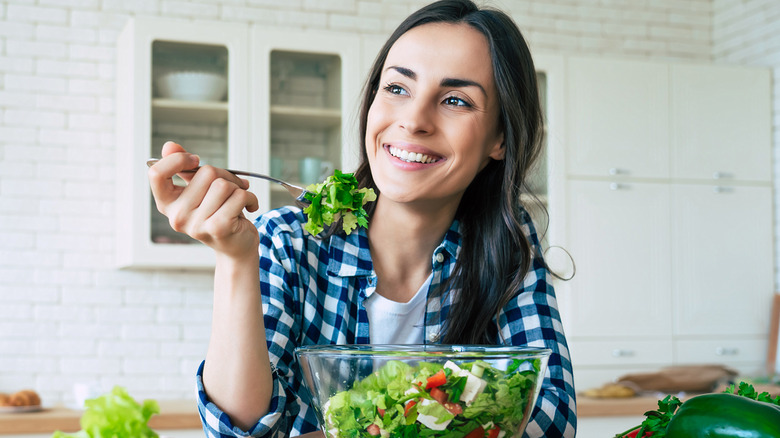Everything That's Not Healthy About Eating Veggie Pasta
Vegetarian pasta has a certain reputation. It's considered the "good guy" of the starch world — the one carbohydrate that's not actually a carbohydrate because it's made with vegetables. Is that actually true, though, or is vegetable pasta masquerading as something far healthier than it actually is?
It's helpful to understand the complexities of veggie pasta. At its core, it consists of standard pasta noodles made partially with vegetables. "Partially" is the key word here. It turns out that there may be something to veggie pasta being a little less healthy than meets the eye, but making the right choices can help you feel better about the pasta that you do choose to eat.
Weeding out the truly good from the faux good, of course, can be a tricky proposition. That's why there's so much back and forth about whether vegetarian pasta is actually healthy in the first place. If you're thinking of modifying your noodle intake and want to make sure you're on the right track, you need to know what's not exactly healthy about that plate of veggie pasta. Is it as good as eating a salad? Can you swap one for the other and feel virtuous about your meal? Start here so you can take your diet in the right direction.
It isn't nearly as versatile
While people may universally feel like conventional pasta isn't healthy and eschew it for the so-called healthier veggie option, the latter doesn't exactly hold the same cachet where flavor is concerned. If people don't like how vegetarian pasta tastes, they're hardly likely to continue eating it — and may, in fact, be so turned off that they end up turning their backs on it entirely.
There's a reason that it's not exactly considered the gold standard for tasty pastas. Veggie pasta isn't typically made with an abundance of actual, flavorful vegetables. Often, what you're seeing in the form of a green "spinach" noodle is actually just food coloring or a little bit of powder (per Time). You aren't reaping the real rewards of the delicious vegetable — and you definitely aren't gleaning the nutritional benefits it offers in its whole form.
Another reason people often favor standard pasta is because of the sheer variety available. Once upon a time, people may have been relegated to one or two types of noodles. Today, though, there's a variety of pasta for everyone. Per the International Pasta Organisation (IPO), there's no dearth of genuinely healthy options in the "plain" pasta world (including gluten-free, whole wheat, and organic).
Actual vegetables are the superior choice
You may feel like you're doing good by choosing pasta with spinach or carrots in the ingredients, but those aren't nearly as nutritious as noodles made with actual vegetables. Anything from spaghetti squash to zucchini can be a great alternative to real pasta, allowing you to capitalize on the rewards the vegetable offers and potentially offering some great extra benefits along the way.
What happens when you really can't beat the pasta craving, though? It makes sense to combine real vegetables with conventional pasta. Replacing some of the pasta with vegetables yields a heartier, healthier dish that offers even greater nutritional value. That can be priceless, as the vegetables will fill you up with roughage and fiber while adding a dose of essential vitamins and nutrients to your day.
Plus, eating real vegetables with your pasta has an added benefit: It brings an entirely new world of creative recipes and flavor options to your palate. You could combine traditional spaghetti noodles with zucchini noodles, for example, to develop a new, more fortified dish that is also incredibly filling. The options are endless, especially if you enjoy pushing up your sleeves and having some fun in the kitchen!
It doesn't actually contain tons of veggies
They may masquerade as being the picture of health, but the simple truth is that veggie pastas don't really contain that many vegetables. What little quantity they do have just isn't enough to satisfy your daily requirements for vitamins and fiber, meaning that the vegetables don't really contribute much in the end — especially if your goal in consuming veggie pasta in the first place was to benefit your diet. Reading the label is key to understanding what you're eating, particularly if you want to add more vegetables to your plate as a matter of habit.
For example, that green spinach pasta that looks so nutritious may only contain a dash of real spinach — and that small amount may come from a powdered or liquified version of the vegetable. Keith Ayoob, an associate professor of pediatrics at Albert Einstein College of Medicine and Montefiore Health System, tells Time, "It's basically fun and games with pasta. It has great eye appeal."
There's no harm in enjoying that bountiful plate of colored pasta, of course. Just remember that it probably won't fill you up like actual vegetables, nor will it offer the same health benefits as the real thing. You can (and should!) confirm this by reading the label carefully. According to nutritionist Cathe Friedrich, the vegetables should be listed high on the ingredient list.
Real pasta can be nutritionally dense
If your entire motivation is to eat veggie pasta just because it may provide you with more nutrients and vitamins, be sure you're on the right path with that assumption. Because pasta's a grain, it contains a great carbohydrate boost and has all sorts of nutrients and vitamins. You can choose whole-grain pasta to ensure you aren't taking in any refined ingredients, too. By contrast, veggie pasta may be refined or made with another kind of flour.
Where standard pasta is concerned, there's plenty of wiggle room for finding varieties that offer some added nutrition. The classic pasta noodles you buy at the grocery store, for example, may be enriched with B vitamins and iron. And, according to Friedrich, many of the veggie-based pastas on the shelves are made with durum wheat flour and don't contain a significant amount of vegetables at all.
"Some vegetable and bean pastas are often made of a mix of refined flour and then a touch of vegetables, making them not much different from the white pasta alternative," confirms Erin Palinski-Wade, author of "2-Day Diabetes Diet," to Shape magazine. If your primary goal is to increase your vegetable intake, doing so via veggie pasta isn't the optimal method. Eating conventional pasta, though, can occasionally provide a surprising nutritional boost.
It can be kind of like white pasta
You probably wouldn't swap white bread for green bread if you knew the ingredients were fairly similar to the white — and the same theory applies to pasta. When food coloring is the main source of "veggie" in your dish, then you can be confident you aren't exactly soaking up the benefits that you would when eating a full plate of vegetables.
In fact, some dietitians liken veggie pasta to white pasta because their nutritional profiles are so similar. Some people may turn to the former because they're following a low-carb diet, for example, and hope that the veggie option can allow them to enjoy their favorite dish from time to time. That's not the case, according to Marissa Meshulam, a registered nutritionist. She tells Huffpost, "Many of the 'veggie' pasta is loaded with other starches like corn flour or potato flour to make them more palatable, meaning that they are not a lower carb option as some might think. Some tend to have more fiber than white pasta. However, they are overall quite low in protein."
Registered dietitian Amanda Frankeny also offers a sobering reminder to anyone who's hoping veggie pasta will be their new dietary go-to: "...regardless of the kind of pasta you choose, this food is meant to be a small part of your diet balanced with fruits, vegetables, proteins and meats, milk and dairy, and other grains."
The order of ingredients makes a difference
As you now know, some types of veggie pasta are really just standard white pasta with a little bit of color derived from vegetables added. That may give them a different look, but it doesn't do much to change their nutritional profile. This is why paying attention to this nutritional profile, and in particular the order in which the ingredients are listed, is so important if your primary focus is increasing your vegetable intake.
Carissa Bealert, R.D.N., says to Shape, "If your pasta is completely vegetable or bean-based, then that should be the first ingredient. What's listed higher up on the label has higher amounts of it in the product. Many brands will add in a mix of enriched flour or a refined grain (such as white rice flour), so read the back of the box first."
If the ingredient label doesn't quite read as it should, then you may as well eat the traditional white pasta instead. In fact, supplementing it with actual veggies may be a better option, according to Bealert. She explains, "Pasta isn't a bad food when eaten in moderation. The key is to watch your portions and add in whole vegetables."
They can surprise you with their nutritional profiles
Research suggests that Americans consume some 20 pounds of pasta per person every year. Many of them seek out alternatives, but the nutrients associated with some types of veggie pastas may surprise you. Many are higher in calories than you expect, or contain significantly less fiber than you hope. If you're watching what you eat and want to make healthier choices, then it's important to know what you're getting with each bite of veggie pasta.
Given that it's usually a pureed or powdered form of a vegetable that lends the pasta its color and "veggie" title, the pasta itself does not come loaded with a full-fledged slate of benefits linked to whole vegetables. Once the vegetable is processed, it loses many of its minerals, vitamins, and fiber. This is why it's helpful to be mindful of your intake, says Tufts Medical Center dietitian Alicia Romano to Today's Dietitian. "Although these pastas offer an opportunity to get a 'vegetable serving' in the diet, I counsel my patients to make room for vegetables in their whole form, rather than relying on pasta as a vegetable serving," she states.
Fiber is an especially important factor, since many people turn to vegetables in an effort to increase their daily intake. Sometimes, though, that fiber is derived from konjac flour. What's more, while many types of white pasta are enriched with beneficial nutrients like iron and folic acid, the same can't be said for alternative veggie pasta.
It's not a substitute for actual vegetables
The bottom line is that veggie pasta just isn't a substitute for a salad or a serving of fresh vegetables. The good news is that you can prepare vegetables in many different ways, affording you plenty of flexibility to prepare dishes you love. That includes incorporating whole vegetables into your pasta, which will yield a better nutrient return than if you consumed veggie pasta on its own. The only exception is spiralizing your vegetables to make noodles. You can use a variety of vegetables, including zucchini, sweet potato, and squash, to create your noodles, then top them with sauce and seasonings. This offers a simple (and tasty!) way to enjoy a unique, vegetable-based take on pasta.
Frankeny explained to HuffPost, "For the most part, nutrition facts on alt pasta do not significantly differ from the classic wheat variety. The carbohydrates are not significantly less, they only boost protein or nutrients a bit, but they can help you diversify your diet or avoid wheat."
"Did you know that one serving of pasta (1/3 cup cooked) has about 70 calories, 15 grams [of] carbohydrates and 2-3 grams [of] protein?" according to Gina Thayer, RD, of Banner Fort Collins Medical Center. "So, if you are truly craving a good old-fashioned bowl of spaghetti and meatballs, and no veggie pasta sounds appealing, go for the original — just keep your serving size in check."









